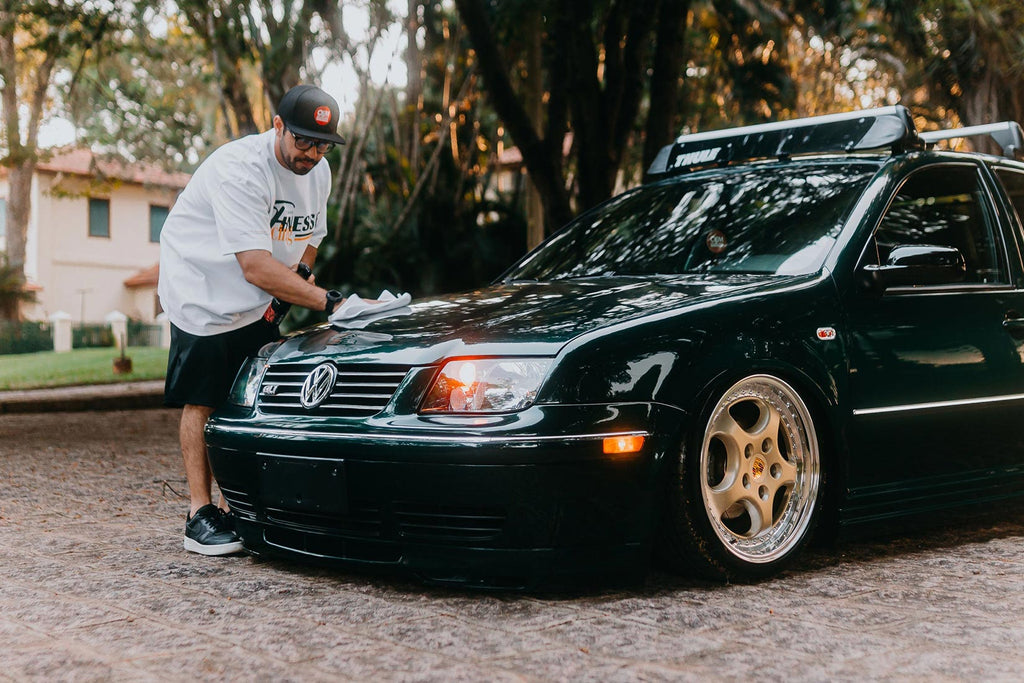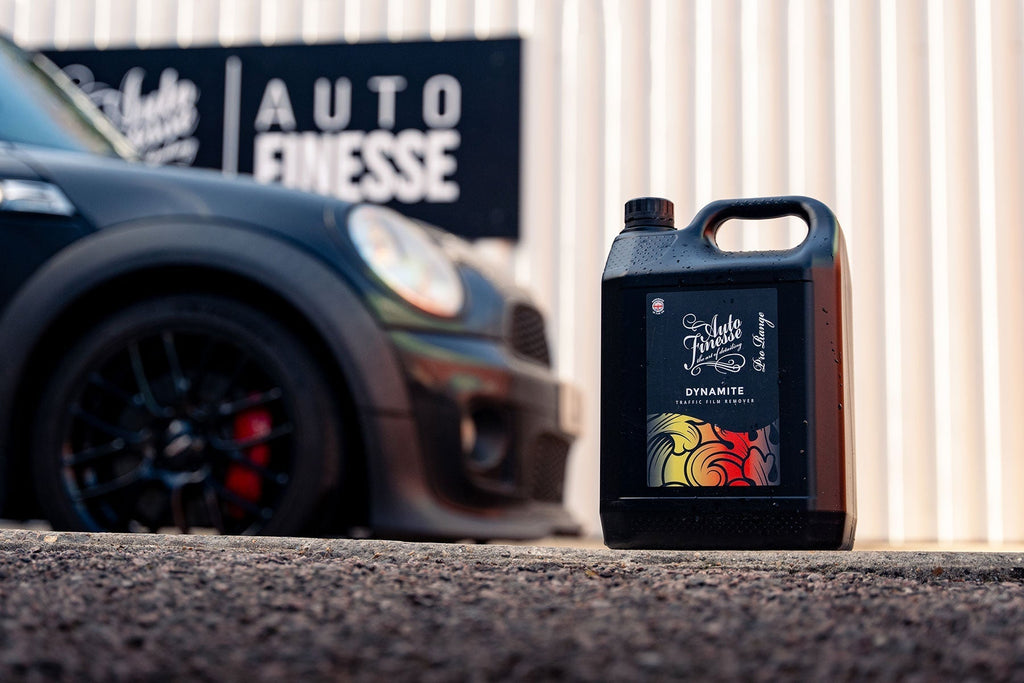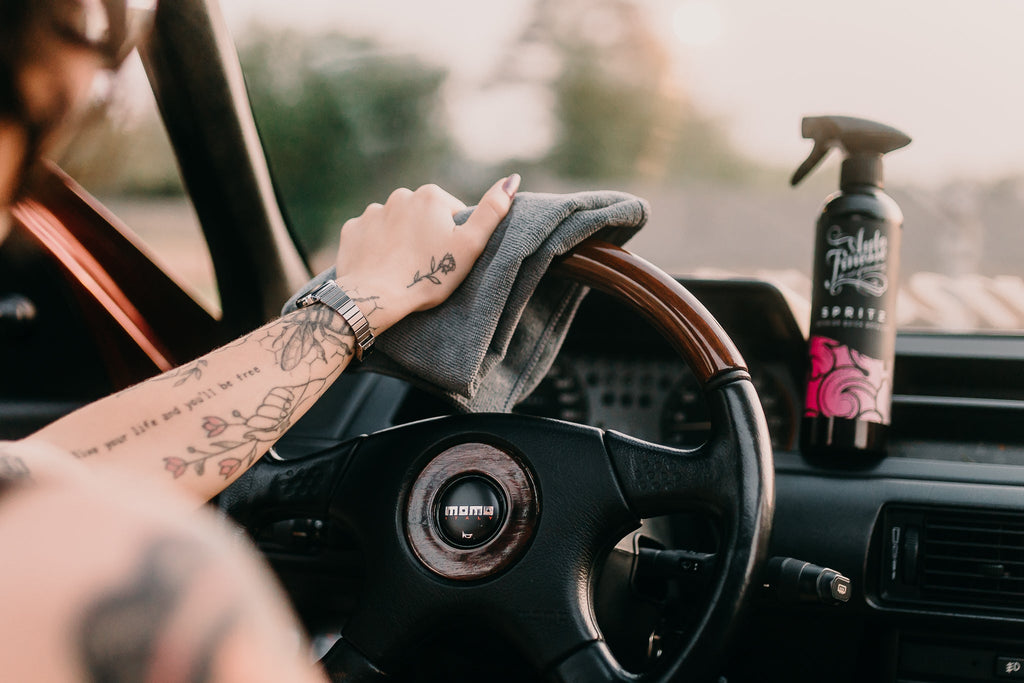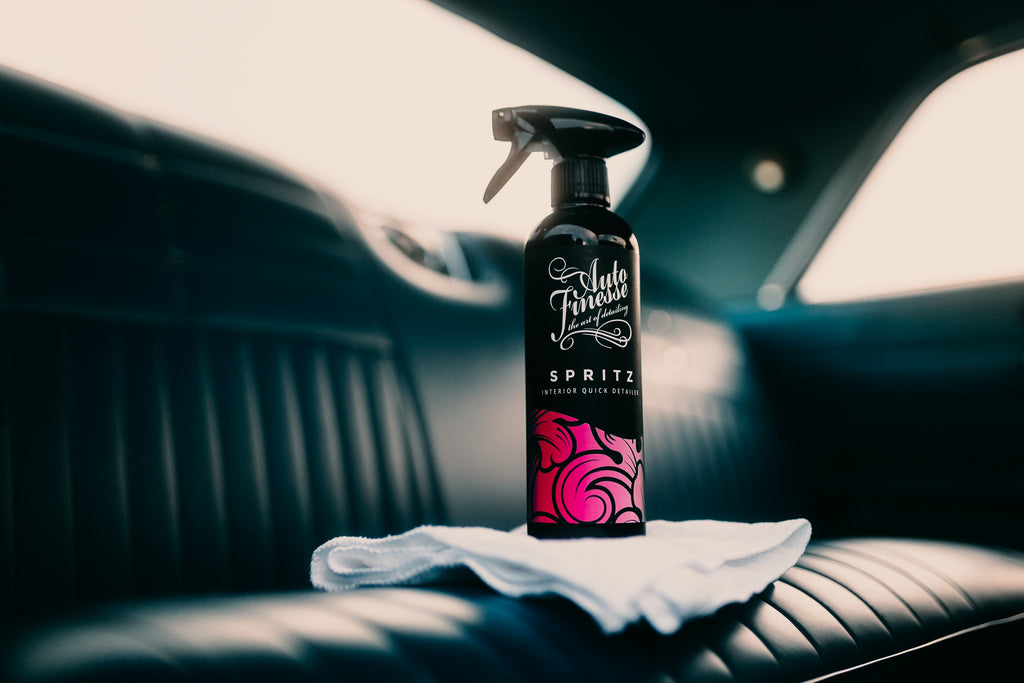Detailing a Fresh Paint Job
A question we've been asked many times - by enthusiasts, show car owners and car detailing professionals alike - is the best way to detail a car straight out of a body shop. It's a good question too, as dealing with issues such as machine polishing new paint, removing abrasive dust and adding protective layers may call for slightly different processes than usual. In fact, many stages, right down to performing a super-safe pre-wash, have a couple of extra things to consider. But, that's where we're here to help, so here's our essential guide containing the professional tricks you need to know, and the best detailing products to use along the way…







Take your detailing game to the next level with the Auto Finesse DPX Dual Action Car Polisher. Developed as a full-bodied, 15mm random orbital DA (Dual Action) ... See product details More
Why Does A Freshly-Painted Car Need Detailing?
The simple fact is that paint can't be flawless until it has been detailed. It doesn't matter if it's a crash repair, bodykit fitting or a full colour change, many forget that paintwork will always need a great deal of refining after being sprayed, wet sanded and compounded by a body shop. It's worth remembering too, that the vast majority of paint specialists make their living through the sheer volume of jobs they carry out. The detailing side, especially when it comes to refining a whole car, will usually take longer than the earlier prepping and painting stages. This costs the body shop more, and the bill gets passed to you, it's as simple as that.
But, this is about more than saving a few quid, because it's pretty much impossible for a painter alone to create a show-worthy finish. For the most part their job is merely to produce paintwork that's passable on everyday cars. Even on the rare occasion that a body shop specialises in show cars and exotica, they are forced to employ a detailer, more often than not off-site, to refine the final finish. Although it's always easy to get caught up with how good the physical transformation of any "full-respray' looks, you have to look a little closer.
Most of all, it's important to think of body shops as refinishers, rather than detailers. Having a capable painter for the first few stages is crucial, but the final finish can only ever be as good as the time (which incurs the extra labour costs) spent on the last refinement stages.

Refinishing Processes
Aside from the preparation, priming and painting stages, a refinisher will perform several tasks before any sort of paint refinement can begin. First, they will wet sand the car to level the surface. This is because, contra to popular belief, fresh paint isn't anywhere near flat when it's first laid down. In fact, it will need plenty of sanding to create a level surface suitable for compounding.
After wet sanding they will move on to compound, or "cut' the paintwork. This begins with a heavy cutting compound, to remove the worst abrasion and sanding marks. They will then switch to a medium or fine compound to blend the paint, help to level the optical finish and install some degree of gloss. This shine may be good enough for an untrained eye on an average road car, but is unlikely to be quite as refined as a true detailing enthusiast would expect.
These initial refinishing compounds are relatively coarse abrasives designed to work with a rotary polisher and give a passable sheen, but for the most part will not be fine be enough for a show-worthy finish. You'll find that, in direct sunlight (or under a specialist detailing light), you'll nearly always see the swirl marks, holograms and other imperfections left behind. It's these that need to be further refined by a detailer.
One other thing to note is that a body shop will almost never add any paint protection layers. This is because, even when the paint is baked-on, it will need anything up to a month to fully cure… and they simply don't want your car sitting around for that long.







The ultimate professional detailing light, the Auto Finesse Swirl Spotter is an indispensable tool for taking your paint enhancement and correction processes to... See product details More
What To Look Out For
So, we know that paint correction is a must, but as you'd expect this can only be carried out on an extremely clean surface. It also means that the washing and decontamination stages are also crucial in preparation for machining.
The three other main considerations when cleaning and finishing a car with fresh paint are; removing harmful dust, eradicating any overspray, and adding the final protection to the paintwork…

Abrasive Dust
A body shop environment isn't what you'd call ideal for paint refinement, or for keeping your car clean in the first place, and this is mostly down to dust. Old paint, fibreglass, body fillers and rubbing compounds all break down to form coarse abrasive particles when they're sanded… and there's certainly a lot of sanding that goes on in preparing any car for the paint booth. This problem is only compounded by having multiple cars under the same roof, because these fine particles have the ability to travel through the air and transfer to other surfaces.
The first issue here is that abrasive dust will inevitably land on your uncured paintwork and, although the body shop will wash the car before they hand it back, that doesn't mean they'll necessarily wash it as safely as a detailer would. The second problem is that this dust will also find itself in many other places. Cars are often stripped down to their component parts for painting. Bonnets and bumpers are usually taken off, and doors may also be painted separately. This means that, even with some degree of protection, abrasive particles will be able to get to a multitude of unusual places during the preparation stages, chiefly before the car is finally masked up for the actual painting. Wheels, interiors and engine bays are most susceptible to picking up dust, and this will all need to be removed. .

Overspray
Parts that aren't being painted are always masked, but just like dust, paint can easily travel to unexpected places, even more so because it uses a propellent to become airborne, and floats around as a mist. A little overspray here and there is common, no matter how carful the body shop, and this will need to be removed after the paint has dried. Most refinishers will do their best to clean away any overspray, especially in obvious areas, but you may find a little that's been missed on areas like window rubbers, plastic trim, wheel arch liners and sometimes even interiors. Don't forget that many of these guys churn out paintjobs all day every day, so now and again some will get missed, they're only human, right? For the most part too, random patches of overspray are only really highlighted when doing a full detail. Just another example of the difference between what's expected from an everyday driver or car trader, and the sort of standard required by a detailing enthusiast.
Luckily, it's not a problem, overspray is usually only created by a fine mist that has indirectly landed on and unprepared surface, it may be stuck on there, but it's unlikely that it will be fully bonded. This means that, with the correct products, it can be removed relatively easily.

Post Polish Protection
This is perhaps the most confused part of detailing any newly-painted car. It goes without saying that your fresh paintwork will need protection from the elements - because you'll be out and about showing off your new hue - but considering the curing times when choosing your product is also crucial.
As we said, fresh paint can take up to a month to fully cure to a hardened surface. There's what's known as an "initial cure' - this is after 24hours or so when the paint is hard enough to sand and polish - the reason that it's perfectly acceptable to refine paintwork before it gets to its final hardness. After this initial cure however, there is still a "gassing out' period, where the remaining solvents are expelled from the surface by evaporation. This can go on for a month or so, until a final cure is achieved. It's the reason why applying protective layers that are non-permeable - like quartz-based ceramic coatings for example - doesn't allow the paint to breathe and can interfere with the final curing process. It's also why we'd advise avoiding using hard waxes and non-permeable sealants, and instead choose a permeable product like Radiance Carnauba Crème, to add your protection.
Radiance offers 3-months durability so, by the time that period is up, you can carry on using that, safely move on to your favourite Auto Finesse hard wax, or make use of the extreme protection offered by our Caramics Paintwork Protection Kit.

Do It The Auto Finesse Way…
The best way to show you properly is by doing the job ourselves, so we rolled this freshly sprayed VW up to the Auto Finesse Detailing Academy…
Step 1: Engine Bay And Wheels
As with many a full detail, it makes sense to start with the engine bay. Chances are that (especially with a car that's spent some time being prepped with the bonnet off) it will be pretty smothered in dust. In many cases, this will be the hardest hit area, and most paint shops will do little more than blow away the surface dust with an air-line.
Cleaning a dusty engine bay is very similar to cleaning any other bay, just with a little more emphasis on making sure you pre-rinse thoroughly to remove as much of the baked-on dust as possible. So, after protecting any exposed filters and electrics, a comprehensive rinse is a must. From there you can utilise Eradicate Engine Degreaser all over the bay (brushing-in for maximum effectiveness), along with a 1:5 Verso solution for the under bonnet and shuts.
After rinsing and drying, we like to coat the entire bay with Dressle All Purpose Trim Dressing, leaving it to cure for 4-6 hours while we complete the rest of the detail, before wiping up any excess at the end.









Deep clean your engine bay with this engine cleaning must have! Eradicate engine degreaser, the hard hitting grime removing engine cleaner developed specificall... See product details More
The next process of course, would be cleaning away any deposits that have been left on the wheels. Like the engine bay and a few other areas that won't have been painted, the wheels can be a huge dust trap. Usually you'll find a considerable amount under those arches, too, so while the process of using Imperial Wheel Cleaner and Revolution Wheel Soap remains the same as usual, an extra-long pre-rinse can go a long way to lifting off abrasive dust that has settled. What's important here is to eradicate all traces of dust, so pay particular attention to the tyres and wheel arch liners when you're pre-rinsing. Getting rid of these contaminants now will ensure they don't end up back on your paintwork when you move the car.












An acid-free alloy wheel cleaner that can take your rims from shameful to sparkling on every single detail with our powerful. The go-to product for many a car d... See product details More
Step 2: Safe Washing
As with any detail, the pre-wash is the most important stage, but it's even more crucial here due to the amount of abrasive dust you're likely to find.
Now, first thing's first, you'll need to assess the situation. Safe wash or not, your refinisher will have cleaned away the majority of the dust on the outside, and it's unlikely that you've travelled too far from the body shop (or left your car outside long enough) to get sufficiently dirty to warrant using a pre-wash cleaner or TFR. Generally speaking, you won't need any strong pre-wash solutions on fresh, unprotected paint, although in some cases, you may need to adjust your plan to suit. A small amount Verso diluted 1:10 with water will usually be sufficient to remove any light road grime, if say, you've driven a little further than you should have before your detail.
The idea here is to prepare the car for paint correction, and to remove the remainder of the dust and general body shop fallout trapped in the harder to reach, and most often forgotten, areas. First a really thorough rinse with a pressure washer is needed to lift away the worst of these contaminants, particularly inside panel gaps and around trim and window rubbers. You'll be surprised just how much dirt you'll see run away as you pre-rinse, even on a car that looks clean already. When you've rinsed, move on to Avalanche Snow Foam. This will help to remove any of the more stubborn dust, especially if you brush the foam into more intricate areas like grills, inside fuel flaps and along weather strips.
Finally, after another thorough rinsing, a careful 2-bucket wash with Lather Car Shampoo and an Ultra Soft Wash Mitt should see the surface free from abrasives and contaminants.



Step 3: Drying
There should be no need for decon washing with fresh paint, so you won't need to break out the Iron Out or Clay Bar Kit. Before you dry though, just reassess the situation and make certain that the car is free from any more trapped dust that may have been allowed to travel back onto the paintwork. At the same time check the typical dirt traps, like grills, bumper recesses and trims, inside the shuts, panel gaps and wing mirrors. If your car isn't completely clean, washing again now is far easier than trying to correct mistakes later on. When you're happy, a final rinse and dry is all that's left. Be thorough when using your Aqua Deluxe Drying Towel, without using quick detailers or drying aids, and don't forget to mop up any water trapped in your wheels and door shuts.







The ultimate luxury microfibre car drying towel, our Aqua Deluxe is constructed from ultra-dense 1200GSM pile microfibre which smoothy glides over paintwork and... See product details More
Step 4: Interior
Many choose to complete the interior last when performing a full detail. In the case of an extremely dusty car though, it makes sense to attempt to limit the airborne travel of any abrasive particles by cleaning the cabin early on, certainly before paint correction. Your interior is perhaps the biggest dust trap of all, so once again, you'll need to be thorough.
Vacuuming every recess is essential, as is using Total Interior Cleaner all over. Pay particular attention to carpets and floor mats, as these tend to be where the dust settles most, quickly becoming ingrained into the fabric. Basically speaking, you'll want to pull as much out of there as possible. Always make use of a detailing brush to dust out the air vents and awkward areas, and to agitate Total on any plastics that need the extra attention. We find that the areas around the door shuts (where the kick trims may have been removed and stored before painting) can be particularly dirty.
For leather seats we'd recommend Hide Leather Cleaner, and don't forget that a little Wipe Out Interior Disinfectant goes a long way, too.










Auto Finesse Total is a ready to use car interior cleaner which is safe to use on all interior car surfaces. Whether you are cleaning plastic, vinyl rubber, clo... See product details More
Once your cabin is completely free of dust, you can use Crystal Glass Cleaner on the inner glass and Spritz Interior Quick Detail Spray on all the plastics for a factory fresh finish. Once that's complete, there's no need to go back inside until the time comes for you to drive away, so now your interior shouldn't pick up any more contaminants or excess residue from refining the exterior paintwork.


Step 5: Overspray Removal
A clean, dry car is far easier to inspect for overspray. In fact, because everything will be so spotless by now, any imperfections should be highlighted pretty quickly. Typical areas that may see missed overspray are arch liners, window rubbers, and quite often, a very light mist on the odd window.
The vast majority of the time, light overspray can be removed from glass with a little ObliTARrate Tar and Glue Remover and a good going over with Vision Glass Polish. Vision also does a great job of filling light scratches, so you do well to make use of it later in the finishing stages, too.



When it comes to window rubbers and weather strips, spraying undiluted Verso All Purpose Cleaner onto a microfibre cloth, along with a spot of rubbing will remove a microscopic layer of rubber to reveal a fresh finish. Once you start on your window trims, be sure to complete all your rubbers to keep the finish even.


The hardy plastic used to produce inner arch liners and undertrays is a little tougher and, although we typically don't recommend using ObliTARate on plastics, it can be useful for removing overspray here. A good helping of Verso on a Scrubi Spot Pad will also be handy for restoring an as-new look. And of course, you can use Dressle on your inner arches to push them to the next level when you get to the finishing stage.



Step 6: Paint Refinement
It goes without saying that professional paint refinement is a complicated business, so it's rather lucky that we've made it easy with our colour-coded Revitalise System and DPX Dual Action Polisher combo. Without going too far into the science of paint types though (we'll reserve that for a definitive guide to machine polishing), what you need to know here is that most body shops nowadays will use a 2K, 2-stage paint system.
2K means that the paint has 2 components - the actual pigment (the clear/colour) along with a hardener (the catalyst). Where a single component 1K paint - like the stuff you'll find in most spray cans - relies on solvents evaporating off to "air-dry'. 2K uses a chemical reaction between the pigment and the catalyst to cure more quickly and to produce a more durable finish.
A 2-stage paint system refers to the fact that there will be a colour base layer applied with a clearcoat layer over the top. The same 1K/2K rules apply for clearcoat because, technically, it's just a paint without an added colour pigment. The vast majority of the time a professional body shop will opt for the 2K variety.
Conversely, a 1-stage system is paint that contains a primer, colour and topcoat all-in-one, just like what you'll find on many a retro car and modern classic. 1-stage means that it doesn't require a separate clearcoat, and that's why, on the rare occasion that this system has been used on a new paintjob, you may get some colour transfer onto your pad when refining (the actual process is no different).
It's true that plenty of metallics are a 1K base with 2K clearcoat over the top, but that's something of a moot point because what you're actually refining with these isn't the colour layer, it will always be the clearcoat (normally, albeit wrongly, referred to as the lacquer). Finally, candy paints are technically just tinted clearcoats built up over a huge number of layers, so once again, refining one of these is a case of machining top layer clearcoat.`



The Process
The basics of cutting and compounding paint and clearcoat remain the same as with every other restoration, what you're looking to do is to physically remove swirl marks and holograms with a combination of abrasives and friction. For the most part we'd assume that your new paintwork will look pretty good (you probably would have sent it back otherwise) but, under direct sunlight, imperfections can become immediately apparent. The only way to remove these marks is by using a series of abrasive products with diminishing grades of coarseness.
Essentially, you'll be grinding a microscopic layer off of the surface as you machine, to reveal fresh, more level, clearcoat. Bear in mind that a human hair is around 60-microns thick, and your average paintjob around 150-200. Completed correctly, you'll be taking away just 1 or 2-microns with each pass.
Using all three stages of our Revitalise System, along with our DPX Dual Action Polisher, will ensure that you have the correct level of cut in every stage, and prevent you from burning through to the base coat or, even worse, the primer. When it comes to machining, choosing the correct tools and abrasives is everything, we'd recommend a Dual Action polisher over a rotary, especially for novice use, because they are far more forgiving. The nature of the orbital action distributes heat build-up to a wider area (rather than concentrating in one area like a rotary polisher does) to prevent scorching the surface.
After you've worked through all the Revitalise stages, buff with a fresh microfibre to reveal a surface perfectly prepared for application of your protective layers.









The Auto Finesse Revitalise System V2 Car Polishing Kit is a three-step machine polishing paint correction programme and the solution to perfecting your paintwo... See product details More
Step 7: Gloss And Protection
We've already talked about permeable protection layers, but before you add your Radiance Carnauba Crème, Ultra Glaze can be a particularly useful product. This non-abrasive acrylic polymer is designed to enhance paintwork, while further reducing the appearance of swirl-marks. It can be applied by hand or with your DPX Dual Acton Polisher, and leaves behind a glossy, wet look finish. Once you've buffed your Ultra Glaze to perfection, you can move on to the last stage on the paintwork - adding a protective layer or two of Radiance Carnauba Crème.



Step 8: Finishing And Dressing
Of course, getting an impeccably finished car involves a few other processes, it's no different to completing any top-flight detail, is it? The best bit of course, is that this is where you get to use plenty of your other detailing favourites.
As we said before, nothing shows up imperfections like a freshly detailed paint job, so it makes sense to use Revive Trim Dressing on any plastics, Crystal Glass Cleaner on your windows, Dressle All Purpose Trim Dressing under your arches, and dress your tyres with Satin Tyre Creme. Once again, and using the right combination of products, you can give your freshly detailed car the finish it deserves… oh, and don't forget to wipe up any excess Dressle you may have applied to your engine bay earlier.




Step 9: Enjoy
That's all there is to it, and now your car should be ready to show off to the world… so get out there and enjoy the attention!


































